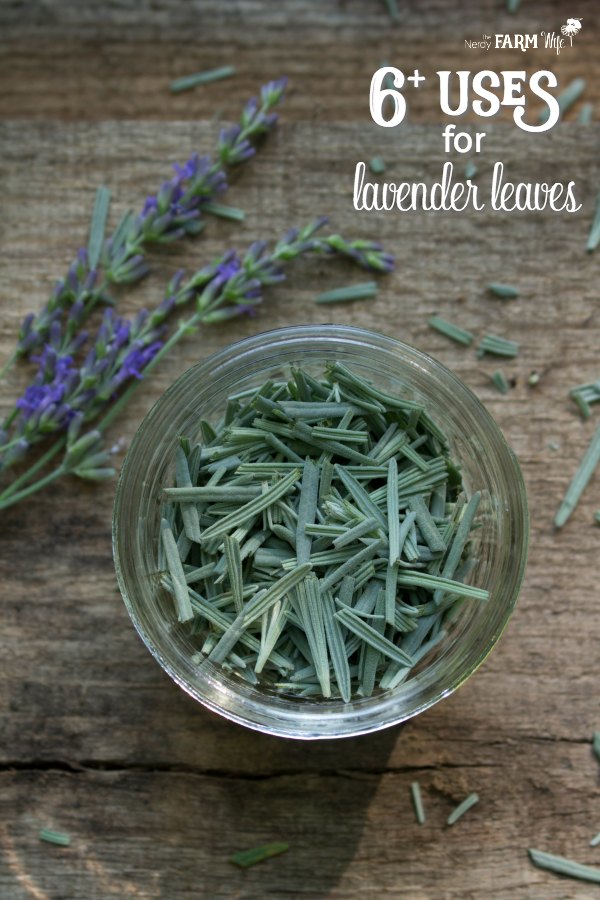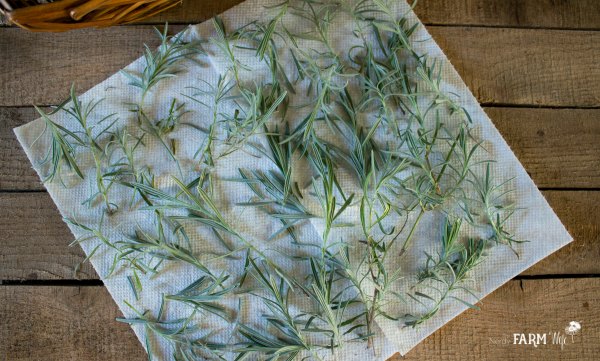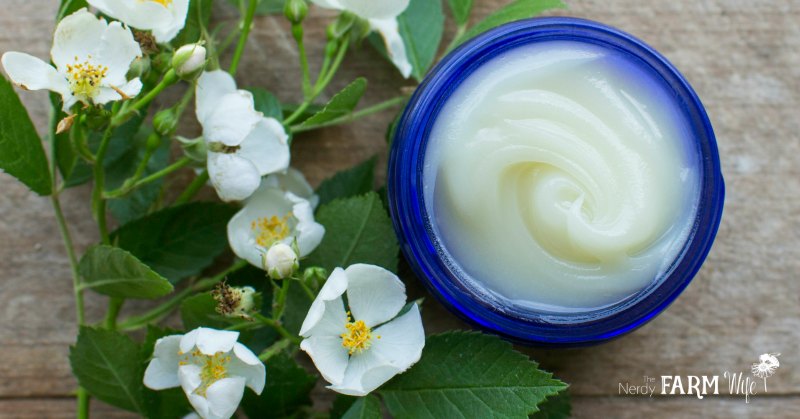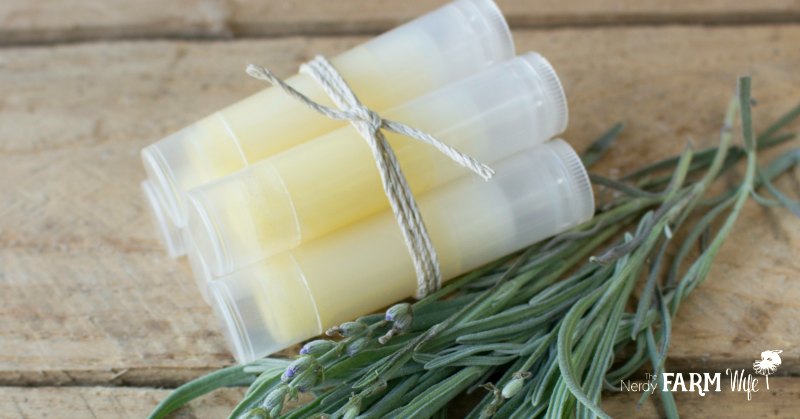6+ Uses for Lavender Leaves
Lavender flowers are only around for a short time, but there are plenty of uses for lavender leaves! Learn how to harvest, dry & use them in DIY projects.

First though, you may wonder – what are the health benefits of lavender leaves?
While the leaves haven’t been studied as specifically or extensively as the flowers, “Lavender (Lavendula angustifolia) flowers, leaves and oil contain linaloyl acetate, linalool, perillyl alcohol, 1,8 cineole (eucalyptol), and at least 100 other known compounds.” (source)
The powerful aroma of the leaves indicates that they doubtless have overlapping benefits with the flowers, which is why I enjoy including them in salves, balms, soaks, and other DIY projects.
It’s also enjoyable just to pick a handful of leaves to rub between my fingers and sniff when I’m walking around my garden – they smell so good!

How to Dry Lavender Leaves
Harvesting and drying lavender leaves is super easy!
To harvest, snip off the top tips of the plant while the leaves are green, avoiding the tougher woody section found further down the stem.
If you just want a handful here and there for a project, then you can snip them any time during the growing season. If collecting a larger amount of lavender leaves, soon after the flowers bloom is a good time to do so.
Next, spread the leaves out on a clean dish towel or paper towel and allow them to air dry for several days. (Learn more about my drying methods by visiting my article, “How to Harvest and Dry Flowers & Herbs from Your Garden“.)
Once dry, store them in a brown paper bag, or a glass jar tucked into a dark cabinet.
As long as they have a noticeable color and scent, they’re good to use. However, if you notice the color or scent of your lavender leaves has faded, then it’s time to compost them.

1. Infused Oil
You can make lavender oil from lavender leaves in the very same way that you make an herb infused oil with the flowers.
To make it: Fill a canning jar about 1/2 to 3/4 of the way with dried leaves. Fill the jar with your favorite oil, such as sunflower, sweet almond, rice bran, etc. Stir a few times to release air bubbles.
For a quick infusion: Set the uncovered jar down into a small saucepan filled with a few inches of water. Heat over a low burner for a few hours, keeping a close eye that the water doesn’t evaporate out. Remove from heat and strain.
For a slower, but stronger infusion: Cap the jar of dried leaves and oil and tuck away in a cabinet for around 4 to 6 weeks, shaking occasionally as you remember to. When the infusing time has passed, strain.
Tip – Use your infused oil to make your own lotion! Here’s a video of me making a simple herbal lotion recipe from my Handmade Lotions & Creams eBook collection. (Sometimes an ad plays first, but the video will play right after! If you have an adblocker you won’t see the video player.)

2. Headache Salve
Use lavender leaf infused oil to make this easy DIY sinus and headache balm.
It’s an all-natural remedy that helps relieve stuffy noses, allergies, and headaches.
Visit my article on Sinus & Headache Balm for the full recipe!

3. Bug Bite Itchy Sticks
These easy DIY bug bite sticks can be made with lavender leaf infused oil to help relieve the itchiness of pesky bug bites.
They’re perfect for outdoor enthusiasts on the go!
You’ll need lavender leaves, sunflower (or other) oil, beeswax, and lavender essential oil to make these handy itchy sticks.
You can find the full recipe for bug bite sticks on my site.

4. Green Lavender Bath Soak
This lovely bath soak features lavender leaves and other fresh green herbs from your garden, such as mint, rosemary, sage, thyme, plantain, violet leaves, or pine needles.
Blend equal parts of fresh chopped green herbs and Epsom salt in a mini food processor.
Spread the green colored salt over a sheet of wax paper and allow to air dry for a day or two, then crumble or re-blend the mix to an even texture.
If desired, stir in 1 to 2 tablespoons of baking soda, to help soften the water, and a few drops of lavender essential oil, for scent.
Add a half batch, or the whole amount, into a comfortably warm bath while the water is running.
For easier cleanup, pour the bath soak into a muslin tea bag or old sock before adding to the tub.

5. Infused Vinegar
To make, fill a jar about 1/2 to 3/4 of the way with fresh lavender leaves. You could use dried leaves as well.
Pour apple cider vinegar into the jar until filled. Stir a few times to release air bubbles.
Cap with a plastic lid, or if using a metal lid, place a few layers of wax paper or plastic wrap between the lid and jar to avoid corrosion.
Steep for at least 3 or 4 weeks, then strain.
Use lavender leaf infused vinegar for:
- a hair rinse after shampooing (dilute up to 1/2 with water)
- diluted to make an after-bath rinse for a dog, or spritzed on to repel fleas & ticks
- mixed with an equal amount of water + pinch of cornstarch to make a glass & window cleaner
- add 1/2 to 1 cup infused vinegar + 1/2 to 1 cup of Epsom salt for a detox bath
6. Cooking with Lavender Leaves
In many recipes, lavender leaves can be used in place of fresh rosemary.
Remember to keep a light hand though, so as not to overpower the dish. You can always add more, if needed!
Try finely chopping the smaller leaves and sprinkling over potato dishes, or include in marinades, herbal spice blends, or vinaigrettes.
Even More Uses for Lavender Leaves
Don’t feel limited to this list!
You can use the infused oil to make lip balms, bath bombs, lotions, creams, and soap.
Or, try including the dried leaves in bath teas or home cleaning recipes. (Like these Herbal Scouring Powders.)
Any time a project or recipe calls for lavender flowers or rosemary, there’s a possibility it might also do well with lavender leaves.


I love this….My husband and I are starting a lavender farm in Iowa next spring….I am in love with all your ideas and have purchased your book…taking your online class about making soap!!!
Hi Kindra, Yay! Thanks so much for buying the book & signing up for the course! Best of luck with your lavender farm; it sounds amazing!
Good information I love herbs so much want to learn more I dry my herbs grind them for cooking
Love this I made a hair oil out of this and rosemary. Very soothing for my scalp. LOVE THE BLOG!?
Hi Aleatra! So happy to hear that – the hair oil combination sounds lovely! :)
Great article. Thank you very much. I’m off to pick my lavender.
Hi Nita! So happy you found the information on using lavender leaves helpful! :)
I loved reading all the uses of lavender leaves n flowers
Thank you for sharing.
Hi Mia, So happy to hear you enjoyed reading about ways to use lavender leaves & flowers! :)
I love all your ideas. Thanks
Hi Betty, I’m so happy to hear that! Thanks for the kind comment! :)
I use the leaves to make tea. Lavender and chamomile tea straight from the garden is divine.
Hi Chere, Thanks for the tip! That sounds like a wonderful combination! :)
The wife and I add them with freshly picked spearmint. Put them in with our coffee in the morning and then brew the pot of coffee. Get an excellent tasting and aroma from the combination. Plus the health benefits from both herbs. Mixed into our morning coffee brew it’s great. We pick the leaves and mint fresh every morning and add it straight in with the coffee and coffee filter.
What a wonderful idea! Thank you for sharing!
Cutting the woody stem of the lavender plant could kill it. Care must be taken only to prune off the soft flexible ends that grow in the spring. This is often done to shape the bush.
This is a bit of a myth, you can actually prune right to the base of the woody stem as long as there is a tiny green bud below where you have cut. I’ve been pruning back lavender in clients’ gardens for years that have been left to get messy, out of shape and woody because people had heard this and were afraid to cut back their lavender plants. The same goes for rosemary and sage, just look for the lowest green bud and cut one bud above it so you have two points for new growth.
Thanks for sharing your experience and expertise with lavender Dizzy!
Lavender in the nesting boxes for chickens reduces or eliminates lice.
Thanks for sharing Fran! :)
My kids go through the bug itch sticks. We need to make more.
Hi Ella, I’m so glad that the bug itch sticks are helpful!
Thank you for sharing. Is really good ?.
Thank you for some great ideas on what to do w the pile of leaves after harvesting and cleaning!
Hi Vivianne, So happy you found the information helpful! :)
Hey, I had no idea how many uses there are for lavender. I’m off to the garden centre tomorrow to buy two or three different sorts. At the moment I am being bitten to pieces by mosquitoes and the bites itch horribly, sounds as though I can make an infusion to soothe the bites which always seem to itch worse when I am trying to get to sleep at night. Many thanks to everyone for all the suggestions.
Anna
Hi Anna, I’m happy the article about lavender leaves was helpful!
Enjoy your lovely new lavender plants! :)
I will try the Lavender Oil for my scalp, great idea. Thanks.
I make herb butter with lavender, it goes great with lamb.
Hi Mecheline, That herb butter sounds yummy!
I hope the lavender oil is helpful for your scalp!
I love lavender and will try almost all of your suggestions. Did you ever try chamomile/lavender tea? It is so calming but doesn’t make you tired and it tastes super delicious. I use 2 teaspoons of dried chamomille with 1/2 teaspoon of dried lavender for one cup of boiled water and let it sit for around 10/15 minutes and add a teaspoon of honey afterward.
Hi Ingrid, That sounds wonderful! Thank you for sharing your recipe with us! :)
I infuse white vinegar with lavender to make a rinse for bedding and to wash my kitchen floor. I usually use the lavender blooms but the leaves work too.